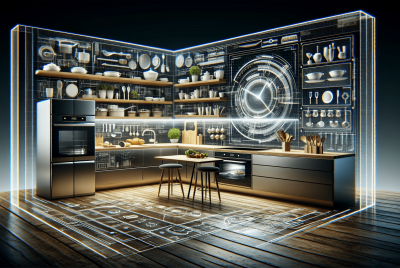What Goes In First Appliances Or Countertops?
Imagine you’re starting a kitchen renovation and you’re faced with a perplexing question: what goes in first, appliances or countertops? It may seem like a simple decision, but the order in which you install these essential components can have a significant impact on the overall functionality and aesthetic appeal of your kitchen. In this article, we will explore the importance of considering this dilemma and provide some insightful guidance to help you make the right choice for your kitchen renovation project.
1. Planning and Designing the Kitchen Space
Determining the Kitchen Layout
When planning and designing your kitchen space, one of the first things to consider is the layout. This includes determining where each component of the kitchen will be placed, such as the sink, stove, and refrigerator. There are several common kitchen layouts to choose from, including L-shaped, U-shaped, and galley. Take into account the size of your kitchen, the available space, and the overall flow of the room. A well-planned layout will not only enhance the functionality of your kitchen but also make it more visually appealing.
Considering the Traffic Flow
Another important aspect to consider when planning your kitchen design is the traffic flow. You want to ensure that there is enough space for people to move around comfortably without feeling cramped or obstructed. Think about how you typically move around in your kitchen and where you spend the most time. This will help you determine the best placement for appliances, countertops, and cabinets to avoid any bottlenecks or obstacles.
Planning for Electrical and Plumbing Connections
Before proceeding with the installation of appliances and countertops, it’s crucial to plan for the electrical and plumbing connections. Consider the location of your electrical outlets and make sure they are conveniently placed for the appliances you intend to use. Additionally, ensure that the plumbing lines are properly positioned for the sink and any other water-related features in your kitchen. Taking the time to plan these connections in advance will save you from costly and time-consuming changes later on.
2. Installing Countertops
Choosing the Right Countertop Material
The first step in installing countertops is choosing the right material that suits your needs and preferences. There are numerous options available, such as granite, quartz, marble, and laminate. Consider factors such as durability, maintenance requirements, and overall aesthetics when making your decision. Each material has its own strengths and weaknesses, so it’s important to select one that aligns with your lifestyle and budget.
Preparing the Cabinets for Countertop Installation
Before installing countertops, you need to ensure that your cabinets are properly prepared. This involves checking for any damages, making necessary repairs, and ensuring that they are level and securely attached to the walls. Sturdy and stable cabinets provide a solid base for the countertops and help ensure a smooth and secure installation.
Measuring and Cutting the Countertop
Accurate measurements are crucial when installing countertops to ensure a perfect fit. Take precise measurements of the cabinets and any sink or appliance cutouts that need to be made. Once you have the measurements, carefully cut the countertop to the appropriate size, making sure to follow manufacturer guidelines for safety and precision.
Securing and Sealing the Countertop
Once the countertop has been properly measured and cut, it’s time to secure it in place. Apply adhesive or screws as recommended by the manufacturer to ensure a secure installation. Additionally, seal the edges of the countertop to prevent any moisture or liquid from seeping in, as this can damage the material over time. Properly securing and sealing the countertop will not only enhance its longevity but also contribute to the overall aesthetics of your kitchen.

3. Installing Appliances
Selecting and Positioning Appliances
Selecting the right appliances for your kitchen is crucial to ensure functionality and efficiency. Consider factors such as size, features, energy efficiency, and budget when choosing appliances. Once you have selected your appliances, determine their ideal positioning in your kitchen layout. Think about workflow and accessibility, ensuring that the appliances are conveniently located and easily accessible for daily use.
Installing Electrical and Plumbing Connections
After selecting and positioning the appliances, it’s time to install the necessary electrical and plumbing connections. This step requires careful attention to ensure safety and functionality. If you’re not familiar with electrical or plumbing work, it’s advisable to consult a professional to handle this aspect of the installation. Proper installation of electrical and plumbing connections will ensure that your appliances operate correctly and safely.
Mounting Appliances Properly
Once the electrical and plumbing connections are in place, it’s time to mount the appliances. Follow the manufacturer’s instructions for each appliance and ensure that they are securely mounted. Improper or loose mounting can lead to safety hazards and potentially damage the appliances. Take the necessary time and care to ensure that each appliance is properly installed and ready for use.
4. Factors to Consider
Kitchen Workflow and Accessibility
When planning the installation of countertops and appliances, it’s important to consider the workflow and accessibility of your kitchen. Think about how you typically move around in the kitchen and prioritize placing appliances and countertops accordingly. For example, if you often move from the sink to the stove, it makes sense to have the countertop between these two areas. By considering the workflow and accessibility, you can create a kitchen that is efficient and functional for your specific needs.
Budget and Cost Considerations
Budget is another important factor to consider when installing countertops and appliances. Determine how much you are willing to spend and prioritize your purchases accordingly. It’s worth investing in quality materials and appliances that will withstand the test of time, but it’s also important to stay within your budget. Consider the long-term value and benefits of each purchase, weighing them against their upfront costs.
Personal Preferences and Design Style
Lastly, consider your personal preferences and design style when making decisions about your kitchen installation. Your kitchen should reflect your tastes and preferences, as it is a space where you will spend a significant amount of time. Consider the overall aesthetic you want to achieve, whether it’s sleek and modern or cozy and traditional. Your personal preferences and design style will guide the selection of materials, colors, and finishes for your countertops and appliances.

5. Pros and Cons of Installing Countertops First
Advantages of Installing Countertops First
Installing countertops first can offer several advantages. First, it allows for a more accurate measurement and fit of the countertops, as they are installed directly on top of the cabinets. This can result in a seamless and professional look. Additionally, installing countertops first allows you to work around the countertop during appliance installation, making it easier to position and secure the appliances in place.
Disadvantages of Installing Countertops First
On the other hand, there are some disadvantages to installing countertops first. One main disadvantage is the risk of damaging the countertops during appliance installation, especially if heavy appliances are being maneuvered on top of them. Additionally, installing countertops first may limit your flexibility in positioning appliances, as you would need to work around the already installed countertops.
6. Pros and Cons of Installing Appliances First
Advantages of Installing Appliances First
Installing appliances first can also have its advantages. It allows for more flexibility in positioning the appliances and makes it easier to connect them to the electrical and plumbing systems. With the appliances in place, you can accurately measure and position the countertops to fit seamlessly around them. This approach also reduces the risk of damaging the countertops during the installation process.
Disadvantages of Installing Appliances First
However, installing appliances first can present some challenges. It may be more difficult to accurately measure and cut the countertops, as they need to fit precisely around the already installed appliances. Additionally, moving heavy appliances into position can be more challenging without damaging the cabinets or countertops. This approach may require additional adjustments to ensure a perfect fit.
7. Practical Approach: Finding the Right Order
Considering the Kitchen Design
When determining the order of installation, it’s important to consider your specific kitchen design. Assess the layout, available space, and the flow of the room to determine which approach would work best. If your kitchen design prioritizes seamless countertop installation, installing countertops first may be the better option. Conversely, if positioning and connecting the appliances accurately is your priority, installing appliances first may be more suitable.
Assessing the Available Resources
Another factor to consider when deciding the order of installation is the availability of resources. Evaluate your skills and knowledge in areas such as electrical and plumbing work. If you feel confident in handling these tasks, installing appliances first may be a viable option. However, if you are unfamiliar with these areas, it may be best to install countertops first and consult with professionals for the appliance installations.
Working with a Professional Contractor
Regardless of which approach you choose, working with a professional contractor can alleviate much of the stress and ensure a successful installation. They have the expertise and experience to handle all aspects of the installation process and can provide valuable guidance along the way. A professional contractor will also ensure that the installation meets safety and building code requirements, giving you peace of mind.
8. Common Mistakes to Avoid
Neglecting Ergonomics and Functionality
One common mistake when installing countertops and appliances is neglecting ergonomics and functionality. It’s important to consider how you will be using your kitchen and prioritize the placement of appliances and countertops accordingly. Ensure that commonly used items are within easy reach and that there is enough workspace for food preparation. Neglecting ergonomics and functionality can result in a kitchen that is uncomfortable to use.
Forgetting to Account for Measurements
Accurate measurements are crucial when installing both countertops and appliances. Forgetting to take precise measurements or failing to account for cutouts and clearances can lead to installation errors and ill-fitting components. Double-check all measurements before making any cuts or installations to ensure a seamless and secure fit.
Not Consulting with Professionals
Another common mistake is not consulting with professionals throughout the installation process. Whether it’s a designer, contractor, or electrician, involving professionals can save you time, money, and ensure a high-quality installation. They have the knowledge and expertise to guide you through the process and avoid potential pitfalls.
9. Final Thoughts
Customizing the Installation Process
Remember that every kitchen is unique, and the installation process should be customized to fit your specific needs and preferences. Take the time to carefully plan and design your kitchen space, considering factors such as layout, traffic flow, and accessibility. Think about your budget, personal preferences, and design style when selecting countertops and appliances. A customized installation process will result in a kitchen that is both functional and aesthetically pleasing.
Finding the Right Balance
Installing countertops and appliances is an important step in creating a functional and beautiful kitchen. Whether you choose to install countertops first or appliances first, the key is to find the right balance between functionality, aesthetics, and personal preferences. With careful planning, attention to detail, and the assistance of professionals, you can achieve a kitchen that meets all your needs and enhances your overall living experience. So take the time to plan, measure, and install with care, and enjoy your new kitchen for years to come.



